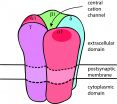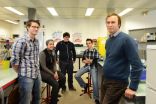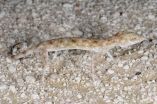(Press-News.org) New Swedish research shows that plasmids containing genes that confer resistance to antibiotics can be enriched by very low concentrations of antibiotics and heavy metals. These results strengthen the suspicion that the antibiotic residues and heavy metals (such as arsenic, silver and copper) that are spread in the environment are contributing to the problems of resistance. These findings have now been published in the highly regarded journal mBio.
Antibiotic resistance is a growing medical problem that threatens human health worldwide. Why and how these resistant bacteria are selected is largely unknown, although it is known that the primary selection takes place in humans and animals treated with antibiotics. Another contributory factor is that roughly half of the antibiotics used in treating humans and animals are, in unchanged and active form, excreted in the urine.
Professor Dan I. Andersson, at Uppsala University, who headed the study, says: 'These antibiotics then disperse, usually in very low concentrations, through sewerage systems into water and soil, where they can remain active in the environment for a long period and so contribute to the enrichment of resistant bacteria.'
Besides antibiotics massive quantities of biocides and heavy metals are also present in the environment. This is due partly to various natural sources (such as heavy metals in groundwater), but also to contamination caused by human activities. Biocides and heavy metals are used mainly to prevent growth of various microorganisms in different contexts. For example, they promote growth in animal production (pigs and poultry), serve as ingredients in anti-fouling paint for boat hulls and as disinfectants for industrial, domestic and hospital use., and are found in products.
Plasmids (small extra fragments of DNA that can be transferred between bacteria) can contain not only antibiotic resistance genes but also genes conferring resistance to biocides and heavy metals, such as arsenic, copper, silver, lead and mercury.
'When these chemicals spread in the environment, bacteria with resistant plasmids will be selected. This indirectly results in antibiotic resistance increasing as well. What's more, in most environments there are complex mixtures of antibiotics, biocides and heavy metals that, together, have intensified combination effects,' Andersson continues.
In the study in question, the researchers performed very sensitive competition experiments in a laboratory environment. They allowed two different strains of bacteria, one susceptiblensitive to antibiotics and one resistant with a plasmid, to grow together in a culture with small amounts of antibiotics and heavy metals present. The results show that very low concentrations of both heavy metals (such as arsenic) and antibiotics, separately or in combination, were able to enrich the resistant plasmid-bearing bacteria.
'These results are worrying and suggest that substances other than antibiotics that are present in very small quantities in the environment can drive development of resistance as well. The results underline the importance of reducing the use of antibiotics, but also suggest that our high use of heavy metals and biocides in various contexts should decrease too,' says Andersson.
INFORMATION:
The study was funded by the Swedish Research Council for Environment, Agricultural Sciences and Spatial Planning (Formas) and the Swedish Research Council. It forms part of a large research programme (INTERACT, http://interact.gu.se) with the aim of understanding how biocides and heavy metals, especially in combination, contribute to development of antibiotic resistance.
Reference: Erik Gullberg et al. (2014) Selection of a Multidrug Resistance Plasmid by Sublethal Levels of Antibiotics and Heavy Metals. mBio. DOI:10.1128/mBio.01918-14.
Very low concentrations of heavy metals and antibiotics contribute to resistance
2014-10-07
ELSE PRESS RELEASES FROM THIS DATE:
Efficacy of potential therapy for autoimmune disorder of muscle weakness
2014-10-07
PHILADELPHIA — Nearly 60,000 Americans suffer from myasthenia gravis (MG), a non-inherited autoimmune form of muscle weakness. The disease has no cure, and the primary treatments are nonspecific immunosuppressants and inhibitors of the enzyme cholinesterase.
Now, a pair of researchers from the Perelman School of Medicine at the University of Pennsylvania have developed a fast-acting "vaccine" that can reverse the course of the disease in rats, and, they hope, in humans. Jon Lindstrom, PhD, a Trustee Professor in the department of Neuroscience led the study, published ...
Advocating weight diversity
2014-10-07
A new review of the way health care professionals emphasise weight to define health and wellbeing suggests the approach could be harmful to patients.
Author of the review article, Dr Rachel Calogero of the School of Psychology at the University of Kent, together with experts from other institutions and organisations, recommends that this approach, known as 'weight-normative', is replaced by health care professionals, public health officials and policy-makers with a 'weight-inclusive' approach.
Weight-inclusive approaches, such as the Health At Every Size initiative, ...
Hospitalized patients don't wash their hands enough, study finds
2014-10-07
Hamilton, ON (October 7, 2014) – Hospital visitors and staff are greeted with hand sanitizer dispensers in the lobby, by the elevators and outside rooms as reminders to wash their hands to stop infections, but just how clean are patients' hands?
A study led by McMaster University researcher Dr. Jocelyn Srigley has found that hospitalized patients wash their hands infrequently. They wash about 30 per cent of the time while in the washroom, 40 per cent during meal times, and only three per cent of the time when using the kitchens on their units. Hand hygiene rates ...
Probiotic yogurt could help protect against heavy metal poisoning
2014-10-07
LONDON, ON – New research shows probiotic yogurt can reduce the uptake of certain heavy metals and environmental toxins by up to 78% in pregnant women. Led by Scientists at Lawson Health Research Institute's Canadian Centre for Human Microbiome and Probiotic Research, this study provides the first clinical evidence that a probiotic yogurt can be used to reduce the deadly health risks associated with mercury and arsenic.
Environmental toxins like mercury and arsenic are commonly found in drinking water and food products, especially fish. These contaminants are particularly ...
The 'cyberwar' against cancer gets a boost from intelligent nanocarriers
2014-10-07
Two years ago, Prof. Eshel Ben-Jacob of Tel Aviv University's School of Physics and Astronomy and Rice University's Center for Theoretical Biological Physics made the startling discovery that cancer, like an enemy hacker in cyberspace, targets the body's communication network to inflict widespread damage on the entire system. Cancer, he found, possessed special traits for cooperative behavior and used intricate communication to distribute tasks, share resources, and make decisions.
In research published in the Early Edition of the Proceedings of the National Academy of ...
Satellite sees Tropical Storm Simon over Baja California
2014-10-07
NOAA's GOES-West satellite took a picture of Tropical Storm Simon weakening over Mexico's Baja California.
On Oct. 7, a Tropical Storm Watch was in effect for Punta Abreojos to Punta Eugenia, Mexico. The National Hurricane Center expects Simon to produce storm total rainfall amounts of 3 to 5 inches with isolated amounts around 8 inches through Wednesday, Oct. 8, across northern portions of the Baja California Peninsula and the state of Sonora in northwestern Mexico. Over the next few days, storm total rainfall amounts of 1 to 2 inches with isolated amounts of around ...
Anorexia/bulimia: A bacterial protein implicated
2014-10-07
Eating disorders (ED) such as anorexia nervosa, bulimia, and binge eating disorder affect approximately 5-10% of the general population, but the biological mechanisms involved are unknown. Researchers at Inserm Unit 1073, "Nutrition, inflammation and dysfunction of the gut-brain axis" (Inserm/University of Rouen) have demonstrated the involvement of a protein produced by some intestinal bacteria that may be the source of these disorders. Antibodies produced by the body against this protein also react with the main satiety hormone, which is similar in structure. According ...
Gothenburg researchers identify molecule that protects women's eggs
2014-10-07
A new study led by Professor Kui Liu at the University of Gothenburg has identified the key molecule 'Greatwall kinase' which protects women's eggs against problems that can arise during the maturation process.
In order to be able to have a child, a woman needs eggs that can grow and mature. One of these eggs is then fertilised by a sperm, forming an embryo. During the maturation process, the egg needs to go through a number of stages of reductional division, called meiosis. If problems occur during any of these stages, the woman can become infertile. Around 10-15% of ...
Closing the gap: Extreme desert gecko spotted on salt-flats in central Oman
2014-10-07
The Gulf Sand gecko is a remarkable desert reptile in that it is the only lizard found habitually on sabkha substrate across large parts of the eastern Arabian Peninsula. These arid salt flats constitute one of the harshest habitats on earth, due to their extraordinary salinity.
The Gulf gecko, Pseudoceramodactylus khobarensis, belongs to a genus with a single species, and it is well adapted to this substrate featuring spiny scales beneath the fingers, long extremities and swollen nostrils.
Data on its distribution range showed a conspicuous gap between eastern United ...
Equation helps assess blood flow to flaps for breast reconstruction
2014-10-07
October 7, 2014 – For women undergoing breast reconstruction using the advanced "DIEP" technique, a simple formula can reliably tell whether there will be sufficient blood flow to nourish the DIEP flap, reports a paper in Plastic and Reconstructive Surgery—Global Open®, the official open-access medical journal of the American Society of Plastic Surgeons (ASPS).
Drs Joseph Richard Dusseldorp and David G. Pennington of Macquarie University Hospital, Sydney, performed an ultrasound study to see how well the flap viability index (FVI) equation predicted blood ...




